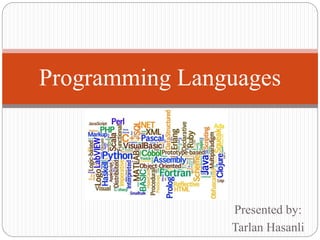
Programming languages
- 1. Presented by: Tarlan Hasanli Programming Languages
- 2. A programming language is a notation for writing programs, which are specifications of a computation or algorithm. A programming language is a special language programmers use to develop applications, scripts, or other set of instructions for computers to execute. There are two types of programming languages • Low level languages • High level languages
- 3. ALGOL Ada AIML Assembly AutoHotkey BASIC Batchfile BCPL C C# C++ COBOL CPL D DarkBAIC dBASE F# FORTRAN FoxPro Go GW Basic HDML HTML Java JavaScript JCL LISP Live Script LOGO Matlab Pascal Perl PHP Pick Python Prolog QBasic R Ruby SGML Smalltalk SQL Tcl True BASIC VHDL Visual Basic Visual FoxPro WML WHTML XML
- 4. A low-level language is a programming language that provides little or no abstraction of programming concepts, and is very close to writing actual machine instructions. Two good examples of low-level languages are assembly and machine code. Programs written in low-level languages can be crafted to run very fast and with a very small memory footprint. Low-level languages are considered more difficult to use, however, because they require a deeper knowledge of the computer's inner workings.
- 5. Machine code or machine language is the name for commands. They can directly be executed by a processor. Usually, they are 1s and 0s. Their order tells the computer what to do. This code is the lowest level of software. All other kinds of software need to be translated into machine code before they can be used. Each processor has its own machine code. Each instruction is made up of an opcode(operation code) and operand(mathematical operation). An instruction tells the computer to do one thing. The operands are usually memory addresses. An instruction set is a list of the opcodes used in a computer. Machine code is what assembly code and other programming languages are compiled to or interpreted as. Program builders turn code into another language or machine code. Machine code is sometimes called native code. This is used when talking about things that work on only some computers.
- 6. Sometimes referred to as assembly or ASL, assembly language is a low-level programming language used to interface with computer hardware. Assembly language uses structured commands as substitutions for numbers allowing humans to more easily read the code versus looking at binary. Although easier to read than binary, assembly language is a difficult language and is usually substituted for a higher language such as C. Below is an example of assembly language in a debug routine.
- 7. A high-level language is a computer programming language that isn't limited by the computer, designed for a specific job, and is easier to understand. It is more like human language and less like machine language. However, in order for a computer to understand and run a program created with a high-level language, it must be compiled into machine language.
- 8. A third-generation programming language, also known as a 3GL, is a programming language that is machine- independent, meaning programs written in that language can be compiled to run on many different devices. This is distinct from a first-generation programming language (machine code), or a second-generation programming language (assembly language), in which the program is written specifically for a certain type of CPU and ISA. The following languages are 3GLs FORTAN C COBOL C++ BASIC Java Pascal
- 9. Fourth-generation languages (4GLs) are even easier to use than 3GLs. 4GLs may use a text-based environment (like a 3GL) or may allow the programmer to work in a visual environment, using graphical tools. Fourth-generation languages (4GLs) are even easier to use than 3GLs. The following languages are 4GLs: Visual Basic (VB) Visual Age
- 10. A fifth generation programming language is a programming language are designed to make the computer solve the problem of you. Fifth generation language are used mainly in artificial intelligence research. Prolog, OPS5 and Mercury are the best known fifth generation languages.